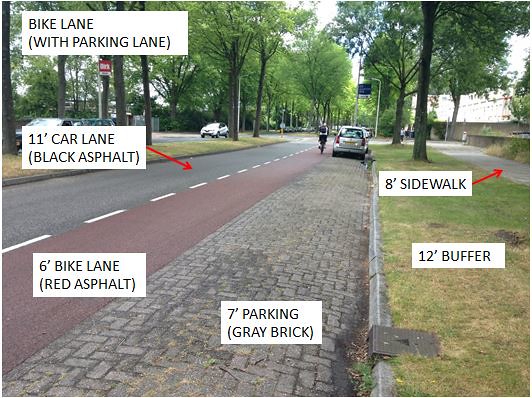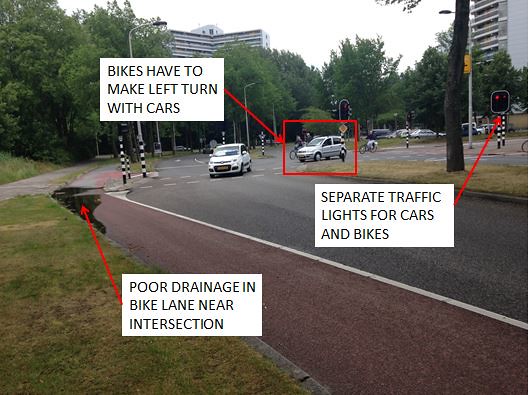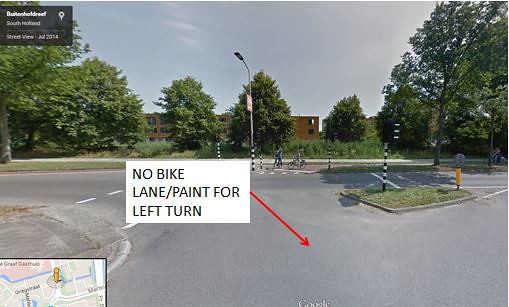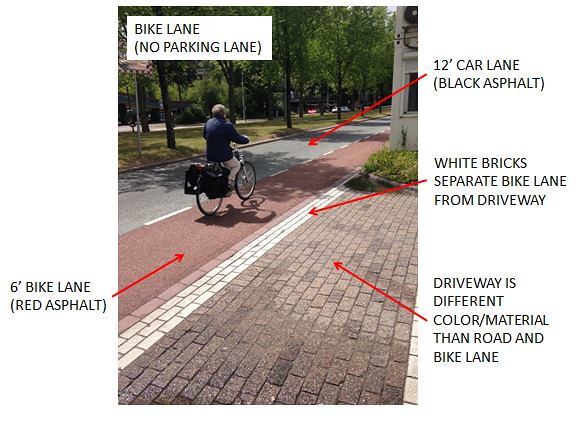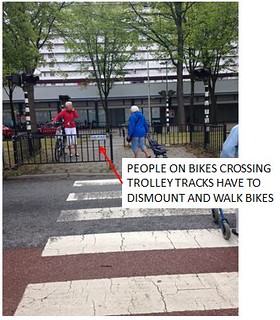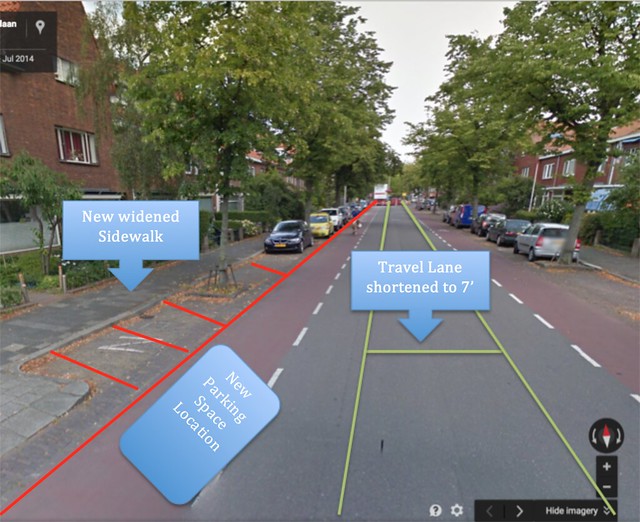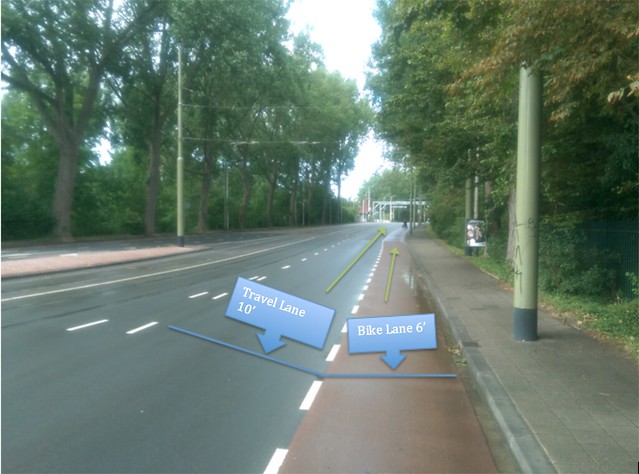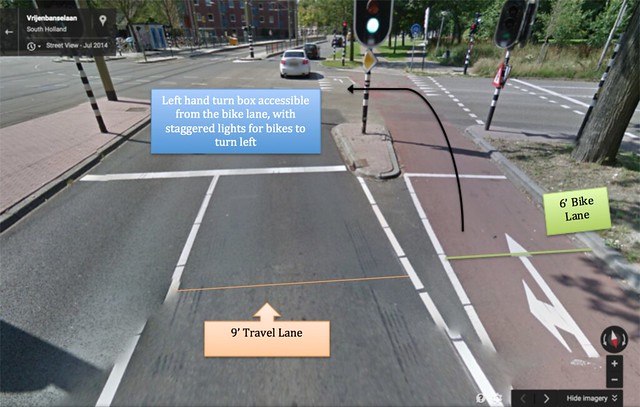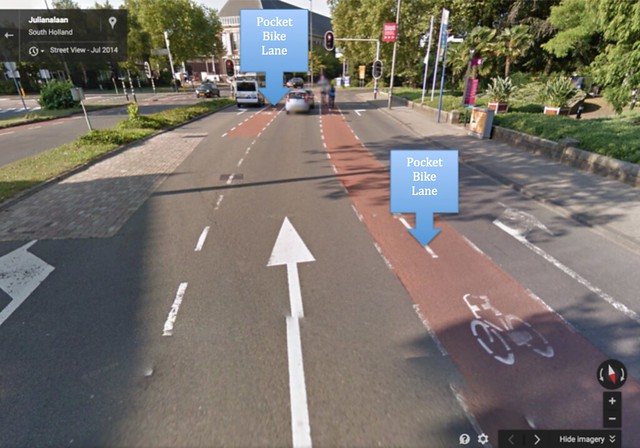Group 2: Kathryn Berger, Jenna Bilsback, Anna Guidi, Stephen Mais, Annie Raftery, Darryl Michaud
Bike Lanes (B)
Overview:
Bike Lanes are designated travel lanes for cyclist use only. They are designated by painted lines, on roadways sometimes with solid paint to better visually distinguish bike lanes from regular automotive lanes. Bike lanes can be located either along the edge of the street or on the inside of a parking lane with varying degrees of buffer. They give the cyclist the relative safety of designated space at a low cost but with little real separation from automotive traffic.
Typical bike lane cross section
http://bikewalktulsa.org/wp-content/uploads/2012/02/4thPlaceBikeLanes.jpg
Bike Lane Map
| Location | Parking | Bike Lane | Travel Lane | Turn Lane | Sidewalk |
| B1 Buitenhofdreef | 7′ | 6′ | 11′ | 8′ + 12′ tree buffer | |
| B2 Martinus Nijhofflaan | 6′ | 10′ | |||
| B3 Hof van Delftlaan – has advisory lanes, not conventional bike lanes | |||||
| B4 Reineveldbrug | 6′ | 10′ | 9′ | 5′ | |
| B5 Julianalaan | 5.5′ | 12′ | 10′ | 7′ |
B1 -Buitenhofdreef
This bike lane is next to a parking lane on the right and a travel lane on the left. There is only one travel lane in each direction. Because people on bikes have to travel next to the driver’s side of the parked cars, there is a risk of dooring. However, the bike lane is relatively wide (6′) compared to the AASHTO standard of 5′. This gives bikes more space so they do not have to travel very close to the parked cars. Furthermore, the parking lane is only 7′ wide, which is relatively narrow considering that parking lanes in Boston are a minimum of 7.5′. The narrower lane encourages people to park their car closer to the sidewalk, which also gives bikes more space. Additionally, the bike lane is painted a different color from the travel lane, and the parking lane is a different color and material than the bike lane. These differences help delineate the bike space from the car space.
Observations: Overall, this street was very pleasant to ride on. Because the travel lane is relatively wide, cars did not travel too close to the bikes. Additionally, we did not observe any cars parked outside of the parking lane. Where Buitenhofdreef intersects with Griegstraat, there are separate traffic lights for cars and bikes. However, people on bikes travelling on Griegstraat who turn left onto Buitenhofdreef have to turn with the cars. Furthermore, we observed poor drainage in the bike lane near the intersection, which caused a large puddle to form in the bike lane. Overall, this street was much more friendly to bikes than streets with bike lanes we have observed in the US, where cars are more likely to park far from the curb or double park in the bike lanes. However, the Griegstraat intersection could be improved by better protecting the bikes turning left and providing better drainage to avoid large puddles.
B2 -Martinus Nijhofflaan
This bike lane is on a street with one travel lane in each direction. It is not next to a parking lane, but there are driveways where cars have to cross the bike lane. The bike lane is separated from the travel lane by a dashed white line and is painted red. The driveway is separated from the bike lane with a solid white line and is made of brick instead of asphalt. The travel lane is 12′ wide, so even large vans do not have to travel too close to the bike lane. These bike lanes are also 6′ wide, like the bike lanes on Buitenhofdreef.
https://flic.kr/p/vwaFVS
Observations: This street was also pleasant to ride on. Cars entering and exiting the driveways yielded to bicycles, and the cars in the travel lane did not drive nearly as close to the bicycle lanes as cars frequently do in the US. However, we observed that there was not a convenient way for bikes to cross the trolley tracks on this street. Because of the way the fences are placed around the crossing, people had to walk their bikes through the crossing. Though this crossing is more inefficient for bikes, it is more comfortable for pedestrians because they do not have to worry about sharing the crossing with bikes that are traveling much faster than they are.
B3 -Hof Van Delftlaan
Hof van Delftlaan has advisory lanes, not conventional bike lanes. Between 2014 and 2015, its layout was changed – while it still has advisory lanes, there is a narrower central driving strip and a widened sidewalk. Looking at google street view from an image in 2014, it shows that this road used to be designed as a typical advisory bike lane road leading into the roundabout. However with a widened sidewalk on the left hand side of the street, the travel lane was cut down significantly and red bricks replaced the asphalt shown on google street view. These changes create a bicycle friendly street where the prevailing behavior was for cyclists to take up most of the travel lane forcing cars to slow down and follow cyclists. This road puts the cars and bikes into the same space slowing down traffic and creating a more relaxed experience.
Before Renovations in June 2014
After Renovations in July 2015
B4 -Reineveldbrug
Observations:
This is a highly trafficked multi-lane intersection with light rail running through the center. It makes use of bike lanes running both directions. It features a two-stage turn box for cyclists attempting to turn left that acts very similarly to a New Jersey jug handle, which allows the cyclist to go straight with the traffic, then stop and wait to cross the street when the cross street gets the green.This seemed to be one of the poorer designed and higher stress intersections for cyclists. This is because of the multiple lanes and added complication of the light rail. The pedestrian infrastructure also seemed to be lacking around this intersection. There was a lack of crossings and the sidewalk was exceedingly narrow due to overgrown bushes and trees without the required buffers.
Bike Lane and Travel Lanes
Intersection with left hand bike turn box
B5 Julianalaan
Julianalaan starts as a typical road with right hand side bike lane at above minimum widths, but at the intersection, the road splits to 3 turn lanes and two 5’5″ pocket bike lanes – one for thru bikes and one for left-turning bikes. This gives cyclists ample space to make the required turns in the complicated intersection ahead. This serves as an interesting comparison to bike lanes in the US because this intersection is so well designed. The multiple pocket bike lanes give great confidence and visibility. However in the US, bike lanes often end and require bikes to ride in the same lane as coming up on an intersection. This is especially dangerous on fast multi-lane roads common in US design.
